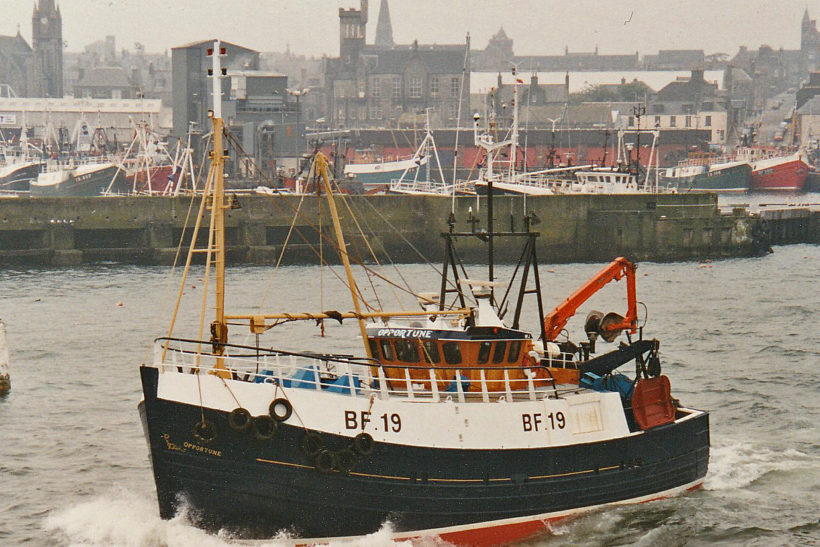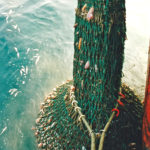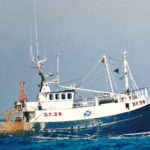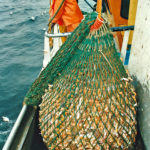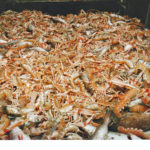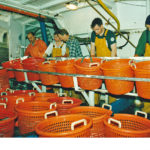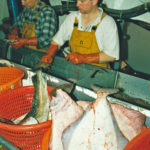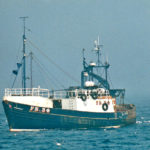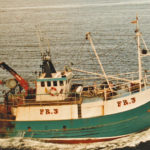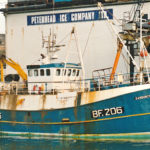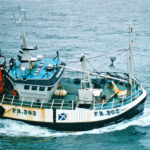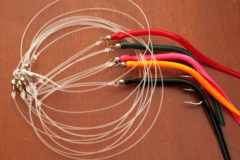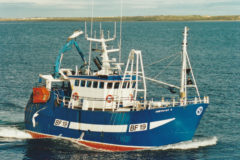David Linkie looks back 23 years to a five-day trip on the Fraserburgh twin-rig prawn trawler Opportune BF 19
Eight hours after throwing off the ropes, on the ‘back o’ Sunday night’ at the Broch, Opportune settled her gear in 70 fathoms and started to tow 60 miles east of Fraserburgh, offshore from the Buchan oilfield on the North East Shoal.
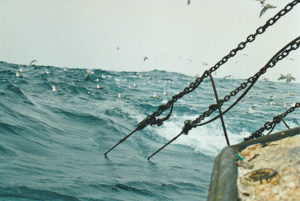
Opportune turning to starboard while towing the twin-rig gear.
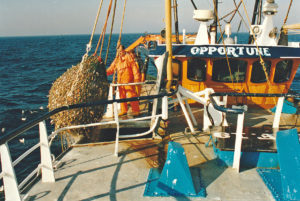
Taking a lift of prawns aboard 60 miles east of Fraserburgh.
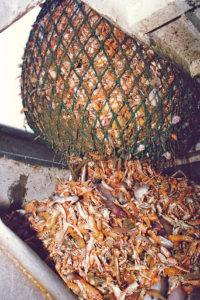
Releasing the contents of the port codend into the catch hopper after a successful tow.
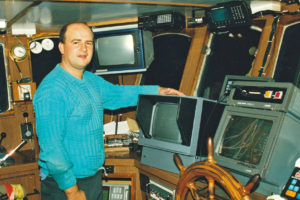
Opportune skipper David West.
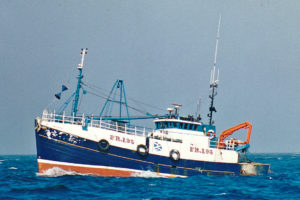
Mystic towing past Opportune.
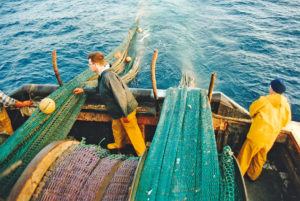
Shooting away the prawn trawls…
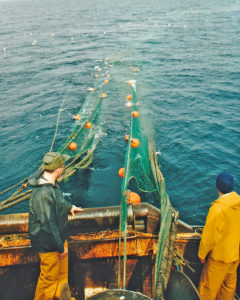
… and checking that they are running clear.
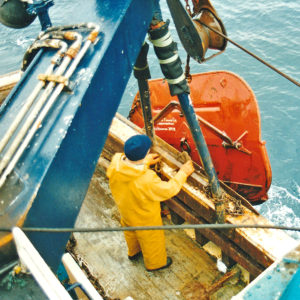
Preparing to release the 7ft Dunbar Hi-Flight double-keeled V port door…
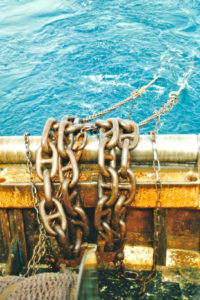
… and the 385kg chain clump.

Pleiades towing ahead of Rebecca and astern of Golden West…
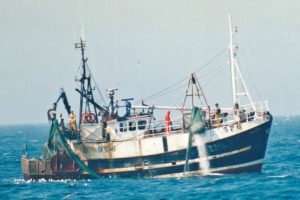
… before hauling and taking the codends aboard.
Skipper David West and mate Ralston Johnson were accompanied on this August 1997 trip by net and hold man David Smith, cook Alan West and Ralston Johnston Snr, standing in for regular driver George Ireland.
With breakfast cleared away, skipper David West took the watch and discussed the twig-rig fishery, while the crew took their last opportunity of the week for a few hours in their bunks.
David West explained that the main reason behind the success of twig-rig trawling for catching both prawns and whitefish is the improved ground contact achieved through two bellies, rather than the simple spread of the gear, which is not that much more than with a conventional single trawl.
Fine-tuning of the gear, based on hard-won experience and skill, was identified as being the key to successful twig-rig trawling, as there are more variables, and therefore greater opportunity for misalignment, than with most other fishing methods.
The size and positioning of the middle clump weight is of vital importance. Allowing for the 8ft of chain worked behind the trawl doors, the middle warp is marked to be between 4ft to 12ft longer than the two outer warps, depending on the length of wire shot and the depth. This configuration ensures that the middle warp is showing slightly higher, indicating that it is taking the greater proportion of the towing strain, thus enabling the trawl doors to drift outwards for optimum spread.
The middle warp needs to lead the gear attack just in front of the trawl doors to get the middle of the nets fishing optimally so that the bosoms take the prawns or whitefish. The weight of the middle clump is relative to a boat’s towing ability, with increased weight ensuring better ground contact. Some of the smaller twig-rig trawlers were using 180kg chain clumps, while some 70ft boats were successfully fishing with 680kg weights.
The Opportune class of vessel generally worked five-day trips, fishing anywhere in an arc stretching clockwise from the Noup grounds off Orkney, as far east as the Fladen grounds around the Claymore, Tartan, Piper and Ivanhoe oil platforms, and southwest to the Forties, Nelson, Kittiwake and Buchan fields on the Swatchway grounds, trying to limit steaming time whenever possible, and landing for the Saturday morning market at Fraserburgh and Sunday at home – even if poor weather had curtailed fishing earlier in the week.
The bigger class of 70-80ft twin-rigger targeting higher-value groundfish using 100mm mesh and landing a by-catch of prawns mainly fished further offshore from the Foula, Ocean Monarch and Bressay waters northeast to the Beryl and Brae fields out to the Norwegian line, encompassing the Fladen grounds and the Maureen rig.
At a time when Nephrops were expected to be allocated a full-blown TAC and a new prawn fishery was being opened up on the Fladen grounds, skipper David West welcomed moves to allocate a discrete Fladens quota separate from the precautionary North Sea allocation, saying that the need to establish accurate track records for prawns caught on the offshore grounds was crystal clear.
Opportune’s twin prawn trawls were supplied by Faithlie Trawl of Fraserburgh, whose nets were as popular with Fraserburgh skippers 23 years ago as they are today.
With 492 x 72mm mesh nets in the fishing circle, the nets were rigged on 170ft footropes. A central 40ft section of 6in discs were spaced at 6in intervals, opening out to a 16in spacing towards the ends of the central section, from where they were replaced by 65ft of clean rubbers to the wing-ends.
Opportune was using 105mm and 75mm mesh codends and a larger meshed lifting bag, with this combination having been shown to be effective in reducing the numbers of small fish taken. A 3m 80mm square mesh escape panel was positioned well forward in the top half of the extension.
Skipper David West worked 50-fathom sweeps, compromising 30 fathoms of singles and 20 fathoms of double rubber legs and headline sweeps, with the outer leg sweeps 8ft longer.
The gear was spread by a set of 7ft Dunbar Hi-Flight double-keeled V doors, which around 90% of the Fraserburgh prawn fleet used at the time of this trip, with the ease of shooting said to outweigh the greater spread achieved by whitefish twin-riggers using various other types of doors.
Traditional chain pennants were worked across the trawl doors, with two spanning to the 385kg middle clump, which consisted of four seven-link sections of heavy chain connected top and bottom to a spreading bar.
While some skippers were starting to use a heavy rolling sphere instead of chains, middle rollers as known today were still some distance off.
Opportune’s 20mm-diameter middle and 18mm-diameter outer wires were supplied by Karl Thomsen of Buckie.
David West explained that the gear-handling was not as complicated as it looked, although expertise, well-balanced gear and a good crew could make operations look deceptively easy. This was demonstrated over the week, when the entire hauling/shooting process was regularly completed within 40 minutes. Opportune usually shot the gear into the wind or before it to ensure a clear shoot, although a tow was not changed to accommodate this preference.
The first tow proceeded eastward at between 2.4 and 2.7 knots from the 1,050rpm engine setting, with 300 towing revs in hand. A fair number of fellow Fraserburgh boats were fishing close by on parallel tows.
Prospects for the week were uncertain, because although the boats had found good fishing the previous week on making tides, which skipper David West preferred, the spring tides scheduled for the next few days were among the biggest of the year. The first tow indicated that there would be very strong tides to contend with all week.
Prawn patterns are notoriously difficult to predict at the best of times, so it was just a case of ‘wait and see’ as to whether or not they holed up.
After usually first appearing in the east for the first three months of the year, prawns normally took off before reappearing on the grounds further inshore – which had appeared to happen two weeks earlier than usual – before again moving east as the year progressed.
The gear was heaved up after five hours. The warps were marked to ensure that the middle clump surfaced first, giving the two door men time to pass the chain pennants onto the net drum before dealing with the doors. Opportune’s split net drums were fitted with full-size central flanges, which enabled two complete sets of twin-rig trawls and sweeps to be carried.
With the fishing lines wound on, a bight of rope was usually taken round the extension piece and the codends towed for a few minutes to clear the nets of mud and slime. The starboard net was then passed over the powerblock and swung around the quarter, before the port net was emptied in the same way.
On occasion, the two codends could become twisted, particularly if there was a considerable weight differential between them. On a good day, this could be freed relatively easily by towing the nets and putting the wheel hard over in the opposite direction to the twist.
The first tow proved rather disappointing, with less than 7st of prawns, although there was a fair sprinkling of higher-value monks, lemons and the odd turbot and halibut to save the day. While steaming for a couple of miles, the crew fitted 36ft tickler chains to each footrope to try to take more groundfish, as Sardonyx II had reported a better haul of prawns but less groundfish using clean rubbers.
Skippers had personal preferences on the rigging of the ground gear. David West thought that tickler chains gave better catches of prawns when fished with discs, although if the bottom was too soft, they were usually removed when targeting groundfish.
As the bottom was quite soft, skipper David West was concerned that, with the big tides, the gear could ‘mud up’ quite quickly, which would effectively stop the tow.
A TV monitor in the wheelhouse enabled him to keep an eagle eye on the three warps chained up at the transom. A lifting middle wire would indicate that the gear was mudding up and starting to lose spread.
With the second tow underway, the crew quickly cleared and sorted the first catch, with the fish and prawns being released from the large hopper to run amidships across the sorting table. During heavy fishing, the crew selected big, medium and small prawns, but this week they were only using the latter two.
The second tow revealed a slightly better return of prawns and fish, with half a lift from each trawl, so the tickler chains were left on. With most of the third tow going to be in darkness, Opportune headed for shallower waters, which can fish better at night.
Skipper David West was using Decca Fishmaster and Racal Decca 3500+ plotters interfaced to Racal Decca GR X 200 GPS and NM 53 navigators for maximum coverage.
Just two hours into the tow, the middle warp was lifting, indicating that the gear was mudding up, so it had to be heaved aboard.
The weight almost proved too much for the net drum, with the starboard net clearly much heavier than the port. Towing washed away some of the mud, but the main cause of the problem was a 50-gallon oil drum full of mud: such are the joys of working in an oil-related area.
Fortunately, the gear was not damaged, so the fourth tow got underway, only to come fast after an hour – twin-rig fasteners are dealt with in the same way as those of single trawls. The net was hauled and quickly shot away again, undamaged.
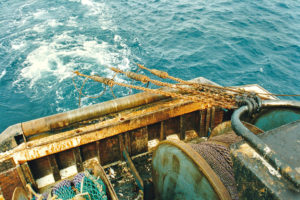
Opportune towing on the chains from a central bracket atop the wheelhouse.
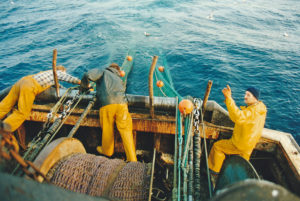
Starting to take the wing-ends onto the split net drums.
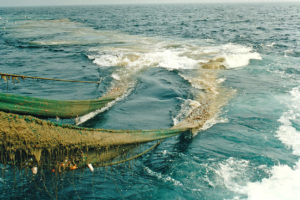
Towing the nets to wash out mud.
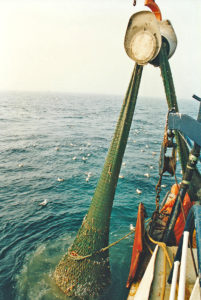
Using the block to swing the codend forward.

Drying up the port bag…
Having lost two potentially good tows, and with other boats in the area reporting up to 15st of prawns, spirits had dropped as Opportune towed back into deeper water. Catch rates picked up from the three tows completed during Tuesday, with 17st of mainly smaller live prawns being the best, supplemented by a fair mix of whitings and haddocks and the odd basket of monks and lemons. The bright spot of the day was that Derek Watt’s Excel, fishing a few miles to the east, had caught 25 boxes of box-length cod.
Despite a long darkness tow during Tuesday night, the 11st was less than expected, although the prawns were of a good medium class. Other skippers reported generally smaller hauls, as the big tides started to bite.
Hauling early Wednesday afternoon, after a shorter than usual tow of four hours to ensure that the gear did not mud up, gave 30st of a good class of very clean prawns, although by now the sprinkling of groundfish had eased. The decks were cleared in little over two hours, partly due to the very low level of by-catch.
The following haul, in the same horseshoe pattern, revealed another good although slightly smaller haul of clean prawns.
This indicated that the fishery had shifted from a night to a daytime one, possibly due to a change of water colour on the seabed. Reports from other boats were now not so good, and David West was pleased with the performance of his possibly heavier gear. This tended to fish well in winter when there was a heavy swell running, but could sometimes be a disadvantage in summer with calm weather and soft bottom.
After another short dusk haul, for not very much, the decision was taken to lie over for a few hours to enable the crew to do some work on the gear, rather than fighting against the peak of the biggest tide.
The tickler chains had been taken off overnight to prevent the risk of becoming muddied up at the peak of the tides. The three daylight hauls on Thursday gave on average 20st of medium prawns, with a few more groundfish, mainly monks, making a welcome reappearance. By now the fishroom was looking healthier, and the crew were in fine fettle.
Having moved gradually east during the past two days, Opportune was now well in sight of the Forties and Kittiwake oilfields. The opening four-hour tow on Friday yielded another 20st, and the gear was quickly shot away again for the last haul of the week, as skipper David West aimed to keep his promise of an early finish to enable me to drive 250 miles south in time to go to Newcastle’s Premiership game the next day.
This began to look less of a certainty when, although towing in an area shown on the plotters to be thick with clear tows, the starboard wire started to lift, indicating a fastener.
Although it was obvious that there was a lot of weight on the gear, particularly the starboard and middle wires, initially the gear seemed to be coming clear. But with about 20 fathoms of warp to come and the gear almost up and down in the water, the starboard wire parted and the other two warps were clearly near breaking point.
A quick check of tide tables and charts confirmed that slack water was imminent and that the time to try to retrieve the gear was now, as when the tide turned, the nets would be pushed harder into the obstruction.
Hauling recommenced cautiously, and after another 10 minutes the centre clump and port door were heaved up, and the safety pennant chains were attached to the split net drum, which now took the full weight of the gear. The starboard net was held by only a single sweep, as the warp had parted earlier. The port net was taken onto the drum relatively unscathed, but the starboard net was still fast.
The heavy weight eventually tore free, and what was left of the net and footrope was retrieved in tatters, with no sign of the starboard door and sweeps. Skippers Derek Watt of Excel and Colin West of Golden West confirmed that they had towed their gear successfully over the same position only the previous week, leaving the only conclusion being that the obstruction had recently been dumped on the seabed.
Whatever the reason, the loss of £3,700-worth of gear (trawl door £600, net £2,100, sweeps £1,000) plus £3,500 for new wires made it an expensive last haul – and a reminder of the dangers crews face every day.
Just after midnight on Friday night, several hours later than anticipated, Opportune was among a succession of twin-riggers making to Fraserburgh to land. Skipper David West and the crew were generally satisfied with their five days’ work, which yielded 94 3st boxes of live prawns and 60 boxes of fish, including nearly 50 of monks, which were sold on the Saturday morning market through the Westward Fishing Company.
The week’s grossing was £10,000. In a typical week, Opportune burned 1,400 gallons of diesel, which represented the bulk of the weekly running expenses. Eight hours later, Opportune was fuelled, boxed and iced, with new doors, warps and net, ready for action 40 hours later.
Just for the record, I was down the road in time to see Newcastle beat Aston Villa, complete with Gareth Southgate, 1-0, thanks to an early screamer from full-back John Beresford.
While steaming in, David West and Ralston Johnston speculated that if the prawn fishery continued going as it was, they might consider building a new prawn twin-rigger in a couple of years’ time – and said that if they did, they’d be more than happy for me to join them for one of their first trips.
Three years later, this became a reality, when the partners took delivery of the 19.9m steel-hulled Amethyst BF 19, the first of a new class of prawn boat from Macduff Shipyards that would be a significant factor in the modernisation of the Fraserburgh prawn fleet over the next 20 years.
A feature looking back at Amethyst’s third trip will be included in Fishing News next week.
Rapid growth of twin-rig trawling
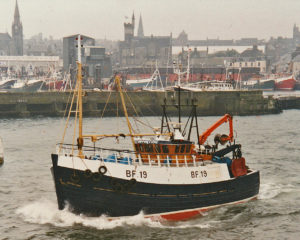
Opportune leaving Fraserburgh to start a prawn twin-rig trip.
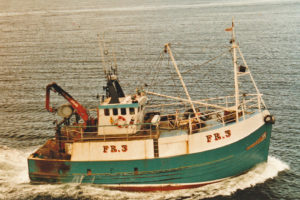
The wooden hulled Ephraim …
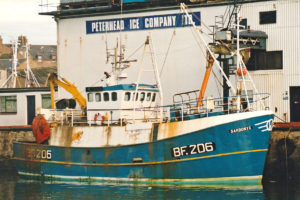
… and the steel hulled Sardonyx …
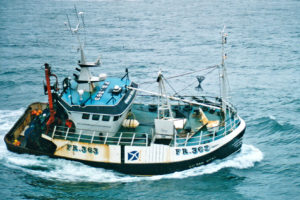
… and Golden West were three of the first of a new class of 18m twin-rig prawn trawler to be built for Fraserburgh.
The move towards twin-rig trawling that started in the 1980s gathered considerable momentum in the early 1990s as skippers started to recognise the benefits it brought. At the time of this trip in August 1997, an expanding fleet of twin-rig prawn trawlers fished from Fraserburgh, as the port continued to establish its position as the leading prawn landing centre in Europe.
By a clear margin, the majority of the Fraserburgh prawn fleet, which included considerable numbers of Gardenstown, Macduff and Banff-owned boats, were former single-rig whitefish trawlers, fly-shooters or pair-seiners that had been converted for twin-rig trawling.
Increasingly prohibitive new-build costs and prolonged lead-in times led a succession of prawn skippers to take the conversion route in order to go twin-rigging, although inevitably this was not without its problems.
Effectively working three wires off already ageing two-barrel winches increased the wear factor and led to more frequent breakdowns. Fitting a purpose-built three-drum winch put additional strain on a vessel’s hydraulic system. By the same measure, boats designed to tow one net but now using two put unintended load on the main engine, thereby increasing the risk of major failure. In turn, fitting bigger engines led to a higher number of gearbox failures.
The 19.9m wooden-hulled Opportune was representative of the class of vessel that emerged as the move towards twin-rig prawn trawling gathered pace, providing work for gear manufacturers and UK shipyards.
Built by Macduff Shipyards in 1985 as a seine-net boat for skipper David Ewan, Opportune was successfully converted for the twin-rig under skipper Iain McLean by Macduff Shipyards. A three-drum trawl winch was mounted forward on the main deck, and split net drums on the open quarter, where seine nets used to be worked from deck ponds across the transom.
Having previously successfully worked twin-rig by using 100-fathom split wires from the two-drum winch of the 52ft Silver Line BF 52 – which he bought from Bridlington whitefish skipper Peter Watkinson in 1991 – David West, in partnership with mate Ralston Johnson of Gardenstown, bought Opportune in 1996.
Few fishing methods have risen to prominence as quickly as twin-rigging did. After first being introduced by prawn trawlers, it replaced pair-trawling and conventional single-boat trawling for whitefish and prawns as the most popular and successful method of fishing in many areas.
The marked preference for conversion in the prawn fleet was in contrast to the pronounced trend for investment in new boats in the whitefish sector. A succession of 24-40m twin-rig trawlers, including Andromeda, Audacious II, Caspian, Carvida, Endeavour IV, Just Reward, Marigold, Marina Polaris, Ocean Bounty, Resplendent, Russa Taign, Seagull, Solan, Solstice II, Sunbeam, Vandal and Westro, had either been delivered on were being built in 1997.
The wooden-hulled Ephraim FR 3 and Avocet FR 162, along with the steel-hulled Sardonyx FR 207 and Golden West FR 363, built by Gerrards, Hepworths and Miller’s in 1987 and 1988, were among the first of a new class of 16-18m twin-rig trawlers built for Fraserburgh.
In 1989, Macduff Shipyards delivered the 18.6m Heather Sprig BCK 181, the yard’s first steel-hulled boat, to Buckie skipper John Smith, and the 21m wooden-hulled Aurelia BF 15 to local skipper Ian Scott, who immediately started prawn twin-rig trawling from Fraserburgh.



